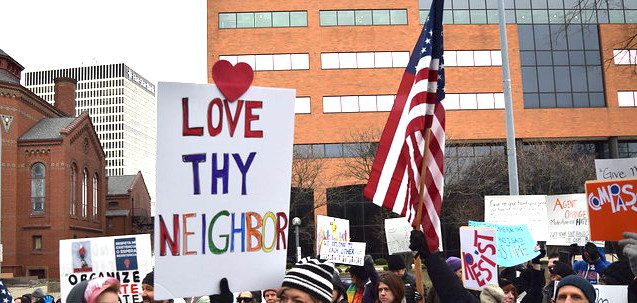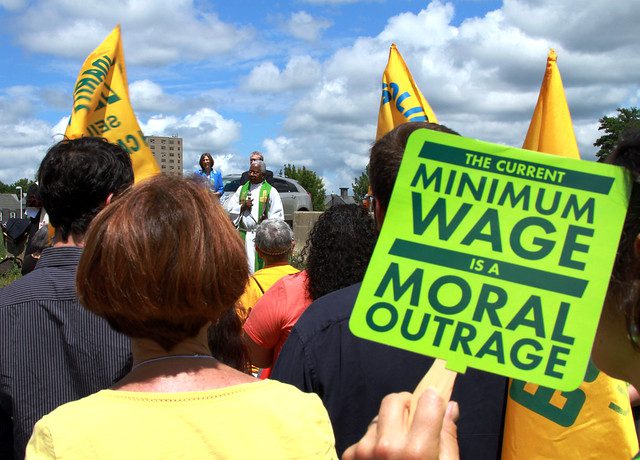
Multi-unit homes. Photo credit: Arlinton County via flickr, CC BY-SA 2.0.
Most low-income households live in one- to four-unit houses, but they often get overlooked in the affordable housing world. Enterprise Community Partners and New York City’s Department of Housing Preservation and Development are looking to do something about that with a new program, HomeFix, which helps low- and moderate-income owners of multi-unit properties with repair loans, which are hard to get in the private market. The loans will be low cost, and in some cases even forgivable, and funded by bank settlement funds from the NY Attorney General’s office. Although it’s being billed as a program supporting homeownership (which it is), tenants in two- to four- multi-unit buildings should also benefit from improved conditions in their homes, especially since Enterprise Community Partners says most loans will come with some requirement to preserve affordability in the rental units.
If you watch television you’ve likely seen commercials for Credit Karma, the free credit monitoring service that provides customers with regular updates on their credit score and connects them with credit and lending institutions based on their scores. Amidst a tight lending market where fewer people are applying and being approved for, loans, a Wall Street Journal article reports that some auto and mortgage lenders may start to share their criteria with Credit Karma. In doing this, the company can inform customers of their “odds” for a loan approval without a hard inquiry “hit” to their credit, potentially encouraging people to formally apply. With over 80 million Credit Karma customers, this change may benefit people who did not think their credit history qualified them for beneficial loan rates, or a loan at all.
The city of Milwaukee, like so many other cities, is working on getting its hands around the problems of vacant homes and lack of affordable housing. But they might not be thinking enough about the broader health of the neighborhoods they are working in. One neighborhood association president told CityLab that several city-refurbished houses lost their front porches entirely, with the new residents parking in the alleys and entering without ever seeing their neighbors. Seems like the design team should have talking to Indianapolis about the health benefits of porches.
Denver voted on Monday to extend the required affordability period for city-subsidized affordable housing from 20 years to 60 years. This puts it more in line with other cities, whose requirements range from 40 years to in perpetuity. Preservation of affordable units is crucial right now, especially in rapidly appreciating markets. A new report out shows that nearly half a million LIHTC units will reach the end of their federal affordability restrictions between 2020 and 2029, leading to concerns about conversion to market rate in desirable neighborhoods and need for recapitalization in struggling ones.
*This* is how you respond to a strike that affects your conference: Race Forward has moved all of its participant room reservations out of the Westin Book Cadillac Hotel after its workers joined the multi-city Marriott strike. In an email to participants, the conference organizers encouraged anyone else with rooms there to switch their reservations and not cross the picket line, and noted they are inviting striking workers to address the conference. (Of course this was an easier lift than it might have been because there were non-striking Marriott options to move to, and it wasn’t the main conference venue. Nonetheless, we’re confident they would have done the right thing under more difficult circumstances as well.) As quality jobs, rather than number of jobs, becomes a primary battleground for economic fairness, it’s something any nonprofit that hosts conferences should be prepared for.
Striking Marriott workers, whose slogan is “One job should be enough,” would probably not be surprised by the recent results highlighted in Raj Chetty’s Opportunity Atlas that found no correlation between job growth and economic opportunity/mobility out of poverty.
What questions should a global citizen science project be answering? That’s what Earth Challenge 2020 wants to know. Their highlighted topics include air quality, water quality, biodiversity, and human health. (The US State Department is involved, so we guess they can’t mention climate change directly?). Anyhow, especially under “human health” it seems like it would be a good idea for community development and other organizations working on equity and justice to submit suggestions that revolve around environmental justice and equity—perhaps even just requests that race, ethnicity, and income be included in the data sets. Send your suggestions here.
It is nice when an elected official not only proposes policy that shows consideration of communities, but admits that said policy is a work in progress with flaws and who is asking for critics’ help to make it better. Such is the case with New York City Council Speaker Corey Johnson, who in response to an increased rate of small business closures has proposed the Small Business Jobs Survival Act, which would protect office and retail business from steep rent increases. Responding to a change in the fabric of city neighborhoods when they lose critical retail and services, along with local job loss and a loss of tax revenue, Johnson’s proposal unfortunately also would protect larger chain stores. Johnson has also proposed a vacancy tax on building owners who leave spaces unrented for long periods. In an interview in which he invited critics for help in crafting a better bill, Johnson gave what could be the quote of the week: If you’re Goldman Sachs, you’re treated the same way as a bodega. That doesn’t make any sense.”
More than 2 million households use housing vouchers to help pay for rent, yet only 1 in 3 are protected by nondiscrimination laws that prevent landlords from rejecting the voucher as payment. A Center on Budget and Policy Priorities report shows that local source-of-income protection laws can increase voucher acceptance, which would give voucher households an opportunity to live in more areas. The report also offers suggestions to address community and landlord concerns. We’ve reported on this issue in the past, and explained how households have trouble finding homes that accept vouchers, and when that happens, they lose the voucher (but, of course, they don’t lose the need for housing assistance). So it’s important that these laws become more widespread on the state and local levels.
We’re keeping our eyes on the CVS/Aetna merger. We’ve previously written about there being fewer independent or retail pharmacies in communities of color, which could lead to a public health crisis. Places like Chicago and Northwest Indiana are seeing this growing trend, where low-income neighborhoods are becoming “pharmacy deserts” due to pharmacy closings. And remember when activists across the country were outraged when they found out CVS was locking up condom displays in communities of color? Based on some of the retail pharmacy’s moves in the past, we plan to keep a close watch on what happens.
We know that a person’s life expectancy can vary depending on where they live, and the differences can be big for people who live in different ZIP codes, census tracts, and even blocks. The Robert Wood Johnson Foundation has released this interactive resource that explores how life expectancy across the nation compares to life expectancy in your area. We were surprised by some of the disparities—some as much a 10-year difference—in communities nearby.





Comments